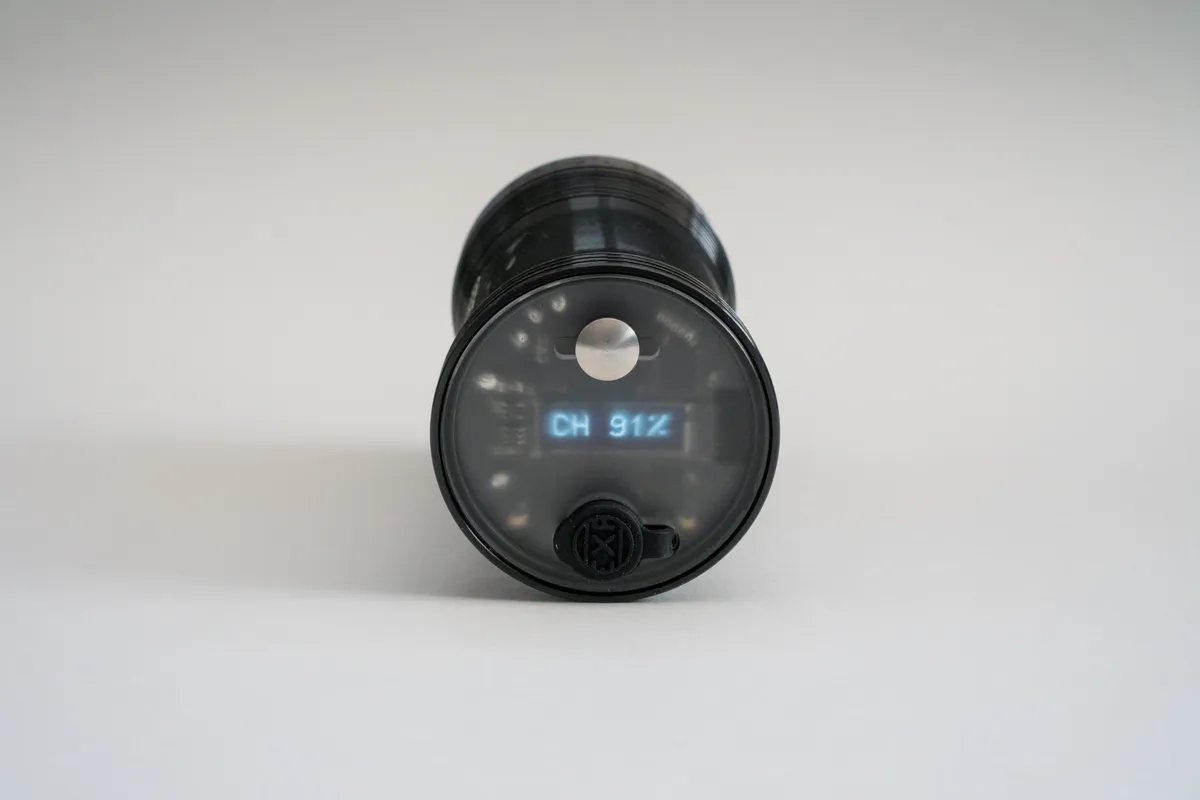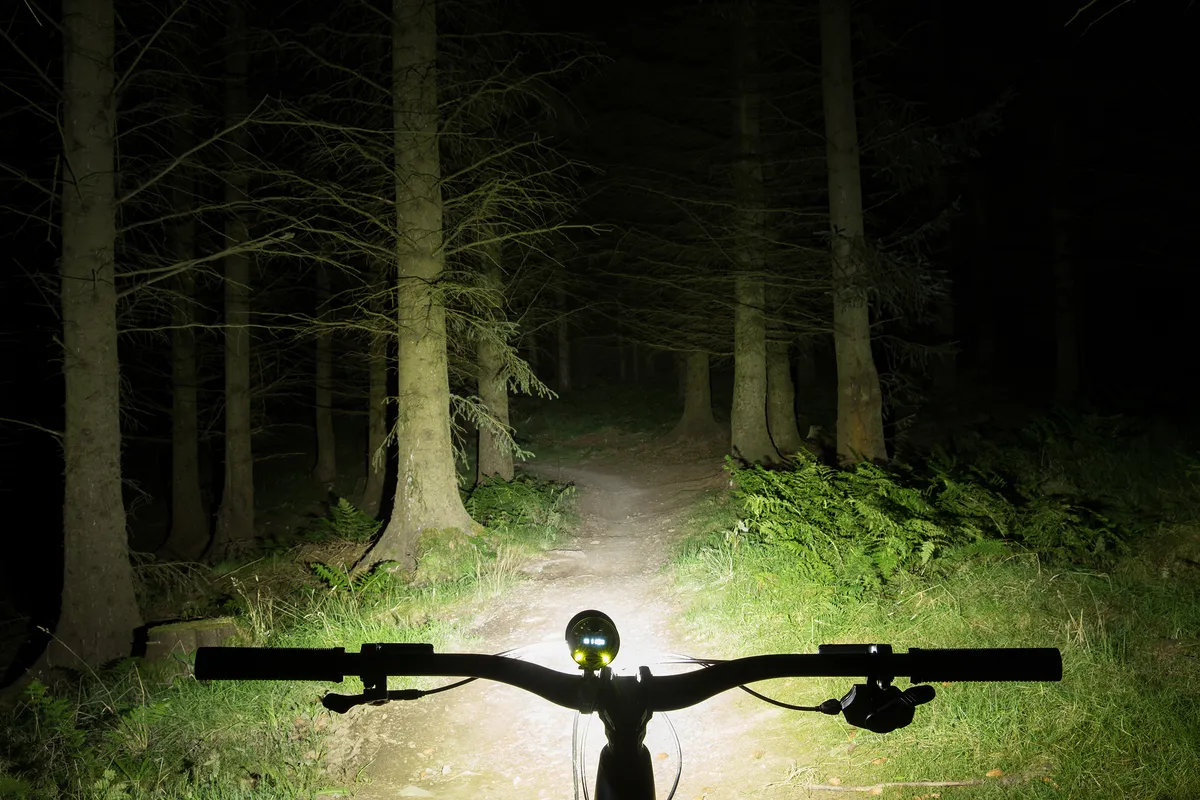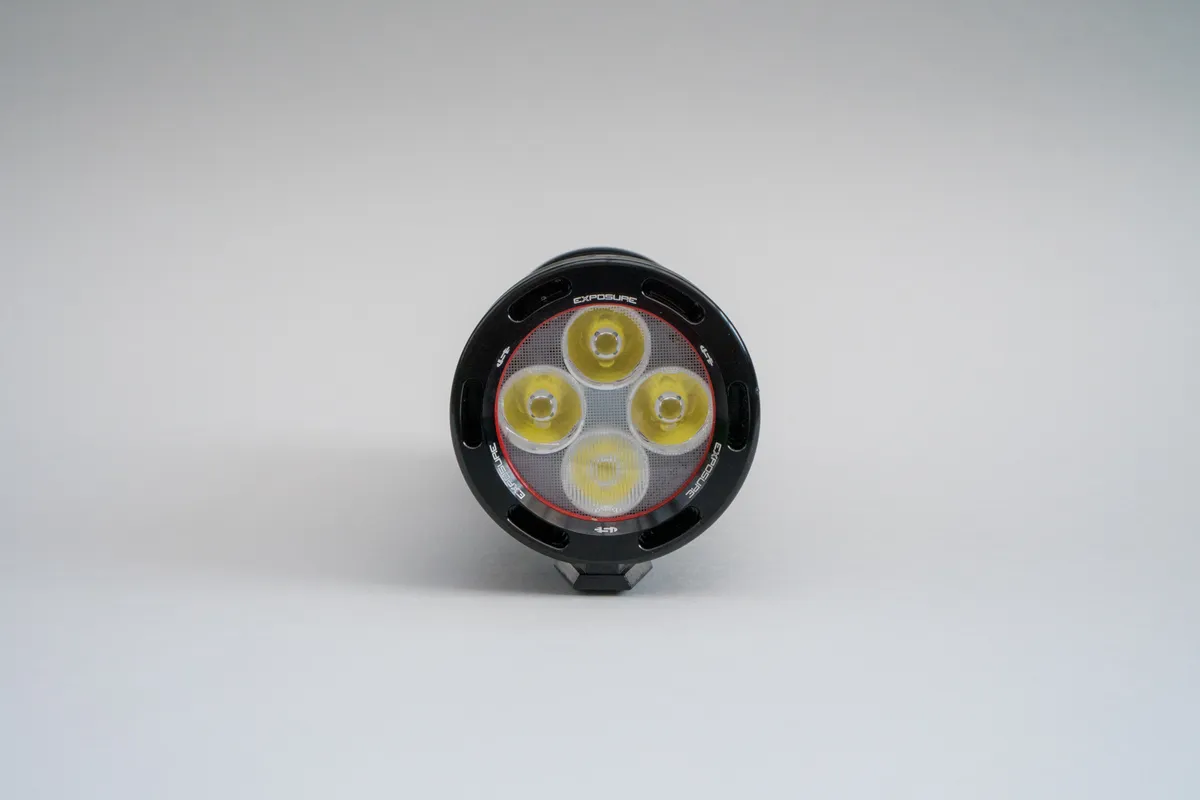Exposure’s latest light, the MaXx D MK13, has some significant improvements over the old MK12 model, including a boost of 400 lumens in the new, enhanced Reflex mode, improved cooling thanks to bigger fins and a tuned optic with four LEDs.
Last year we tested the Exposure Six Pack MK10 and thought the beam’s spread was a little lacklustre, so can the lower-powered MaXx D improve on its higher-powered sibling’s light delivery?
Exposure MaXx D MK13 specifications

The MaXx D MK13 has an all-in-one form factor, where the battery, LEDs, control button and small display are in one unit. There are four XPL2 LEDs at the front of the light, three with spotlight optics and a one with a diffuser lens to flood light.
The four LEDs produce a 2,500 lumen constant output, which can be boosted to up to 4,000 lumens when the light is in Reflex Boost mode. Exposure claims its beam pattern “simultaneously highlights the edge of the trail, without compromising far-reaching beam”.
The LEDs are powered by an 11,600mAh lithium-ion battery that in maximum constant 2,500-lumen output is claimed to last up to two hours.
It features ten user-selectable programmes with varying combinations of lumen output and run time, and each programme has between two and three modes. The programme schema is etched onto the underside of the light and selection is made using the single rear-mounted stainless button.
A small OLED screen displays the light’s current mode and battery charge and run time remaining. There are also coloured LED lights on the rear of the unit that change between red, yellow and green depending on mode and battery charge.

To better manage battery life, the MaXx D has three Reflex Plus modes. Reflex Plus Technology has been refined for the MK13 light so that the transitions between modes are smoother and quicker.
Reflex mode changes the light’s output depending on the trail conditions by using in-built 3D accelerometers to measure speed and bumps – if the light senses the trail’s particularly rough, it boosts output to 4,000 lumens and then dims it back down once it is smoother again.
The cooling fins have been enlarged over the MK12 version by 10 per cent and the air ram entry ports are designed to increase the amount of air that can run over the fins to draw heat away from the light.
The light has a quick-release bracket with a sprung pin that holds it in place. The clamp is compatible with both 31.8mm and 35mm handlebars thanks to the included shim.
Exposure MaXx D MK13 performance

Power from the MaXx D is good and in constant mode certainly feels close to Exposure’s claims. In Reflex mode, maximum power is tricky to perceive and differentiate from the light’s constant 2,500 lumens. This could be because the transition to the brightest setting is smooth – albeit fast – which makes it harder for your eyes to register.
Power was good enough for medium-technical trails, but once things started to get very rough, twisty or technical I didn’t think there was quite enough power to ride with daylight-like impunity. Generally, though, the MaXx D’s power is impressive.
Its beam spread is equally impressive with gradual side-to-side cut-off that stretches out far enough to provide great on-trail context. There is also plenty of light thrown forwards down the trail, although Exposure could sacrifice some of that light to further improve close-range power.
Overall, I was impressed with the beam’s spread and power, and it doesn’t feel like Exposure has had to drastically compromise one of the light’s optics to boost the other, instead its output is very balanced.
Its colour has a white hue with a green tinge rather than blue. This makes it easy on the eyes down the trail and reduces harsh contrasts between light and dark while maintaining good clarity. I found the light very easy to see most roots, rocks and obstacles with.
Reflex mode worked well, and the light’s brightness increased quickly and responsively when hitting rough or fast sections after cruising along smooth trails or being stationary. The feature is great for saving battery life, especially if you’re feeling lazy and don’t want to constantly be fiddling with the light.

As mentioned before, I couldn’t perceived any step up in light output between max constant mode and maximum Reflex output.
Run time in the maximum brightness constant setting was 2 hours and 18 minutes, nearly 20 minutes longer than Exposure’s 2-hour claimed run time.
Once I’d truly mastered how the light operates it became easy to use. However, learning to operating it required a few thorough reads of the instructions and although the button pushes needed to make it work are logical, they aren’t intuitive. For example, to turn the light on, a double push is required and to change programmes a long push is needed followed by additional touches to change modes.
The rear-facing OLED display provides simple and easy to understand information, though, even when you’re on the move. Coloured battery life and mode indicators further help the ease of information consumption.
The mount was impressive. Despite its small size and light weight, it held the light in position without any bounce or wobble over even the roughest terrain.
It’s also simple and quick to remove the light using the quick-release system. However, it sits off-centre of the handlebars, so does take up more space than some other mounts.
Exposure MaXx D MK13 bottom line
The MaXx D MK13 light has fantastic performance and proficiently illuminated even the most obstacle-strewn tracks.
If I was being picky it could do with more power and a slightly wider spread of light, considering the purchase price. If you’re riding really technical trails you might want a secondary, helmet-mounted light to go with it.
How we tested
We put 12 high-power front lights to the test that should let you head to the hills after night falls to discover a brave new world of riding.
Other lights on test:
- Gemini Duo 2200 Multisport
- Halfords Advanced 1600 Lumen
- Hope R4+ LED
- Lezyne Mega Drive 1800i
- LifeLine Ara 2000L
- Lumicycle Apogee Carbon Extender Pack
- Magicshine Monteer 8000S
- Moon X-Power 1800
- MTB Batteries Lumenator 20
- NiteRider Pro 2200 Race
- Knog PWR Mountain Kit
Product
| Brand | Exposure |
| Price | A$619.00, £385.00, $473.00 |
| Weight | 358g |
Features
| Light type | front |
| Integrated battery | yes |
| Features | Run time: 2 hours 18 minutes (max brightness) Battery: <.B>11,600 mAh Lithium Ion Output: 2500 lumens (constant mode) |
